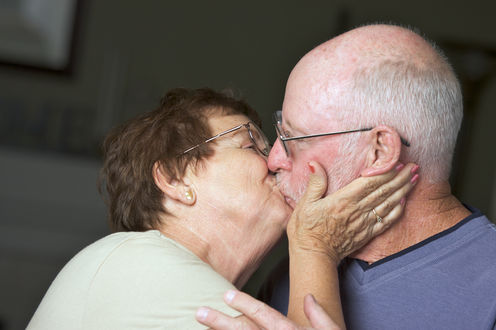
Andy Dean Photography/Shutterstock
Over the past few years we’ve seen a dramatic rise in the rates of sexually transmitted infections (STIs) among Australians aged 60 years and older. Rates of gonorrhoea more than doubled in this age group between 2007 and 2011. Rates of chlamydia also rose significantly during this time, mirroring similar trends internationally.
STIs can be accompanied by some unpleasant symptoms and health complications, or lead to major chronic conditions, in the case of HIV. It’s therefore important STIs are diagnosed and treated, regardless of age.
To understand why STIs are on the rise, we need to know more about older people’s sexual and romantic relationships, their knowledge of STIs and safe sex, and the safe sex practices that they use. However, older people are routinely excluded from research on sex and relationships. Here’s what we know so far.
Changing sexual and relationship patterns
The Baby Boomer generation is renowned for challenging norms around sex and age and this has continued in recent decades.
Improvements to life expectancy and overall health in later life mean that older people may be more willing and able to engage in varying kinds of sexual activity. In fact, there is some evidence to suggest that remaining sexually active is associated with better health in older age.
Changes in the social acceptability of divorce and dating in later life have also opened up the possibility of entering in to a new sexual relationship. With new sexual partners comes an increased possibility of contracting an STI.
Alongside this, internet dating has increased the opportunities to meet new sexual or romantic partners. And medical advances such as Viagra have made (penetrative) sex in later life more of a possibility for older men than was previously the case.
However, this does not mean that all older people are sexually active, or that they are sexually active in the same ways as younger people. Instead, research suggests that older people engage in a diverse range of sexual practices, and may have to adjust to ageing bodies.
Let’s (not) talk about sex
Despite these changes, and increasing evidence that older people continue to be sexually active, there’s a reluctance to acknowledge this shift. Many in the community continue to cling to outdated and ageist assumptions that older people are asexual.
As a result, medical professionals can be reluctant to talk to their older patients about sex. Research in the United Kingdom shows GPs assume the topic of sexual health is not relevant to older people, and fail to proactively raise this issue with their older patients. This is often based on an incorrect assumption that older people are no longer sexual.

This reluctance can have direct and negative implications for the sexual health of older people. It becomes less likely that older patients will be offered routine sexual health screenings , or have the opportunity to ask their GP questions about sexual health.
Learning about safe sex is a life-long endeavour
When we talk about safe sex and STIs, our focus tends to be on younger people. In some ways this makes sense: many younger people are entering their first sexual relationships and need to learn how to have sex safely.
There is also an assumption that older people already know about safe sex. Yet, many older people grew up in a time when comprehensive sex education wasn’t provided in school. For those who have been in long-term, monogamous relationships, using condoms may have seemed irrelevant.
Older Australians need different types of information at different stages in the life course. Those reentering the dating or casual sex scenes, for instance, might benefit from a refresher on safe sex.
Older people might also have unique or different safe sex needs to their younger counterparts. For example, how does one negotiate condom use and an ageing body? How can issues around increased friction and pain that can be associated with condom use (particularly for postmenopausal women) be managed?
We need age-specific education and resources.
Don’t delay treatment
STIs can be costly to treat, and the economic burden of STIs increases with delayed diagnosis and treatment. Delayed treatment can result in more severe symptoms and complications. Ignoring older people as sexual beings may contribute towards poorer overall health and deny their sexual agency.
We need to be more proactive in engaging older Australians around their sexual health. This could start with providing education, access to testing, and opportunities for discussions about sex, relationships, and sexual health.
We also need to know more about sex and relationships among older Australians and what they already know or don’t know about STIs and safe sex. This week we launched SexAge&Me, the first national study of older Australians’ sexual and romantic relationships, to help answer these questions and inform future approaches to sexual health policy and health care responses.
If you’re an Australian resident aged over 60 and want to take part in the survey, click here.
Bianca Fileborn receives funding from the Australian Research Council to undertake research on STIs and ageing.
Anthony Lyons receives funding from the Australian Research Council to undertake research on the sexual health of older Australians.
